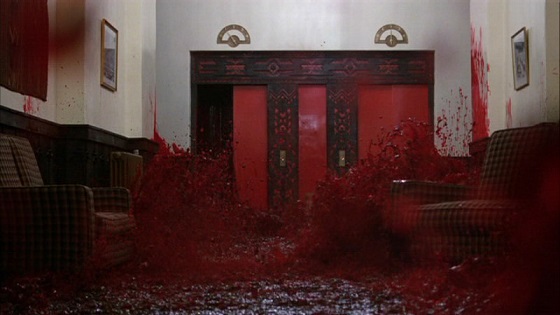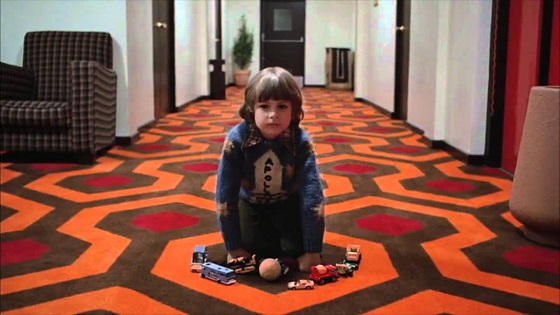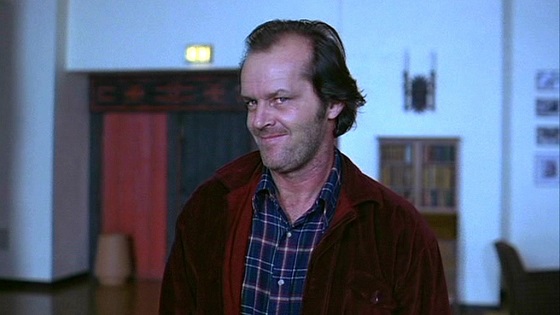‘The Shining’ Is The Stephen King Adaptation That He Hates…
And Everyone Else Loves
A handful of horror movies are just bonafide classics.ô Some are from the silent era, and others are products of the Universal Monsters period of the thirties, but the classics that are remembered most fondly today are the popular fright flicks from the seventies and eighties, movies like Halloween, Friday the 13th, Alien, and even The Amityville Horror.ô Also falling into this timeless category is Stanley Kubrickãs 1980 Stephen King adaptation The Shining.

The Shining is about a recovering alcoholic ex-school teacher-turned-writer named Jack Torrance (Jack Nicholson from Chinatown and One Flew Over the Cuckooãs Nest) who gets a job as a winter caretaker at a posh mountain resort called The Overlook Hotel in Sidewinder, Colorado.ô The job entails that Jack, his wife Wendy (Nashvilleãs Shelley Duvall), and son Danny (one-time actor Danny Lloyd in his iconic role) stay in the hotel and keep an eye on things during the winter months after all of the guests and employees have left for the season.ô The job sounds easy, and Jack is looking for some solitude to work on his next book, so the situation seems ideal.

Except that the hotel has a sordid history of everything from being built on the site of an Indian burial ground to the fact that a former caretaker succumbed to cabin fever and murdered his whole family. ô The ghosts are still in the hotel, and soon enough, they make themselves known to both Jack and Danny.ô The combination of the spooks whispering in his ears and the isolated seclusion turn Jack into a psychotic madman.ô But Danny, who already has a ghostly imaginary friend and a psychic ability called The Shining, may be able to save his mother and himself from his homicidal father.

The Shining was adapted from Kingãs novel for the screen by Kubrick himself and co-writer Diane Johnson (The Divorce).ô It is the precursor to the popular trend that fans of today refer to as ãslow burnã horror.ô It plods along at a deliberate snailãs pace, but every frame is essential, as it ratchets up the tension and raises the stakes with each progressing scene.ô The entire movie simmers just below a boil, exploding just frequently enough and horrifyingly enough to remind the audience that they are, in fact, watching a horror movie.ô Itãs a masterful work and one that is recognizable enough to have been tributed and parodied by everything from ãThe Simpsonsã to Ready Player One.ô The Shining is an irreplaceable part of modern pop culture.

For his part, novelist Stephen King hates it.ô The author of unforgettable books-turned-into-movies like It, Pet Sematary, Maximum Overdrive, Catãs Eye, Apt Pupil, Night Flier, and The Dark Half regards Kubrickãs The Shining as his least favorite of the multitude of cinematic adaptations of his work.ô King does have a point, as Kubrick made the movie more about Jack than Danny, and also portrayed the hotel as full of ghosts instead of being a supernatural force of its own.ô Kubrick took the psychological horror of Kingãs book and turned it into more of a visceral experience.

And, for as valid as Kingãs grievances are, Kubrick did exactly what he set out to do.ô Kubrick had a knack for dabbling in many genres, from film noir (The Killing, Killerãs Kiss) to science fiction (2001: A Space Odyssey, A Clockwork Orange), from war movies (Paths of Glory, Full Metal Jacket) to period pieces (Spartacus, Barry Lyndon), but The Shining is his one and only foray into pure horror, and when he began the project, he both wanted and needed a hit movie.ô And, in typical Kubrick fashion, he made the story as cinematic as can be, with his non-book additions becoming the most iconic images in the film.ô Croquet mallets became axes and topiary animals became a hedge maze, and, much to Kingãs chagrin, Stanley Kubrickãs The Shining became an instant classic.

In dealing with his actors in The Shining, Stanley Kubrick was suitably Kubrickian.ô Jack Nicholson was reportedly frustrated by endless script rewrites, to the point where he wouldnãt learn his lines until minutes before shooting each scene because he knew that they would probably change.ô Shelley Duvall got the brunt of Kubrickãs psychological torture, as the bully director put the poor actress through hundreds of takes of her scenes, each more demanding than the last, in order to coax a genuinely terrified and hysterical performance out of her.
Kubrick showed mercy on Danny Lloyd, who seemed to be sheltered from the storm (mostly thanks to his set tutor/handler Leon Vitali ã see Filmworker for more), so much so that the young man didnãt even realize that The Shining was a horror movie until years later when he saw the finished product.ô Whatever Kubrick did with his actors, it worked, because The Shining contains some of the finest performances of its castãs collective career.

While the cinematography in The Shining is credited to John Alcott (who was a frequent Kubrick collaborator in between shooting other movies like Terror Train and Fort Apache the Bronx), Stanley Kubrick was a very hands-on director, so most of the filmãs look was probably dictated by the auteur.ô Color-wise, The Shining features a muted palette that is sporadically interrupted by scenes that are bathed in bright red or green.ô Just about every scene in the film is framed symmetrically, with the main focus in the center, a technique that has been exploited ad nauseam by quirky modern directors like Wes Anderson.
The real photographic breakthrough came with the extended use of a Steadicam (a camera stabilization device), mostly during scenes where the point of view follows Danny as he speeds his Big Wheel through the halls of the Overlook.ô The photography in The Shining isnãt as inventive as that of Kubrickãs previous Barry Lyndon (for which Kubrick and Alcott had special wide-aperture lenses built so that they could shoot by candlelight), but for what was considered at the time to be a low-rent horror film, everything looks astoundingly good.ô Just as Kubrick intended it.

The soundtrack for The Shining is composed of both original and existing music.ô The non-original score is made up of modernist classical themes from the likes of Bartû°k and Penderecki as well as jazz standards from Ray Noble and Henry Hall.ô Electronic composers Wendy Carlos and Rachel Elkind (both of whom also wrote music for Kubrickãs A Clockwork Orange) filled in the holes with ominous Moog and mellotron pieces that have become highly recognizable themes in horror score history, despite the soundtrack album for The Shining being long out of print.ô While all of the music plays a pivotal role in the film, itãs Carlos and Elkindãs heavy synth and ghostly choir compositions that seal the deal in The Shining.

Always the perfectionist, Kubrick kept tinkering with The Shining even after it was released.ô The original cut of the film contained a final scene that spoon-fed the endingãs meaning to the audience.ô After the premiere and the opening weekend, Kubrick and Warner Bros. asked each theaterãs projectionist to manually cut the scene out and send it back to Warner Bros. where it was destroyed, resulting in the ending that is known today.ô But Kubrick was not finished there.ô For the international release, Kubrick trimmed the film further, excising about 25 minutes and bringing the running time down to under two hours.ô This shorter European version is considered the ãDirectorãs Cut,ã although most fans prefer the longer, more expositional American version.

The Shining may be the most scrutinized film this side of Psychoãs shower scene, and overzealous fans have come up with dozens of hidden meanings and conspiracy theories regarding the film.ô These interpretations include topics as varied as Native American genocide to Kubrickãs supposed involvement in faking the Apollo moon landings.ô A compelling documentary called Room 237 (named after the most haunted room in the Overlook) gathers together a few of these nutcase conspiracies and makes them look a little less like nutcase conspiracies, especially to those who know what a meticulous and detail-oriented filmmaker Stanley Kubrick was.
Although the cast and crew of The Shining have debunked most of the made-up mythology, some of the coincidences are curious, considering Kubrick rarely left anything onscreen to chance.ô Whether you believe or not, Room 237 is a fun watch.ô Just be sure to watch The Shining one more time before you dive in, because some of the stuff in Room 237 canãt be unseen, and much of it changes the movie forever.

Stephen King would end up adapting The Shining himself into a television miniseries in 1997 that was much more faithful to his novel, entrusting director Mick Garris (Sleepwalkers, ãAmazing Storiesã) with bringing it to life.ô He also wrote a sequel to The Shining called Doctor Sleep that is being turned into a movie by horror wunderkind Mike Flanagan, who masterfully adapted Kingãs ãunfilmableã novel Geraldãs Game for the screen last year.ô As for Stanley Kubrick, he would go on to make two more movies, Full Metal Jacket and Eyes Wide Shut, before passing away in 1999.ô King hated Kubrickãs The Shining, so the two never worked together again, but their one collaboration is still one of the best movies, horror or not, to come out of the eighties.ô Cinema fans will always have The Shining.
further reading 7 Surprising Life Lessons Found In Horror Movies

